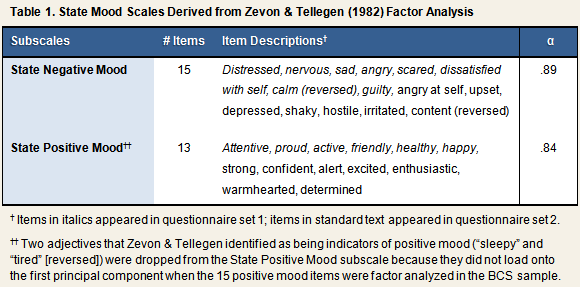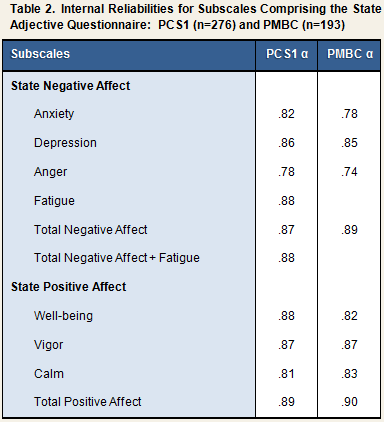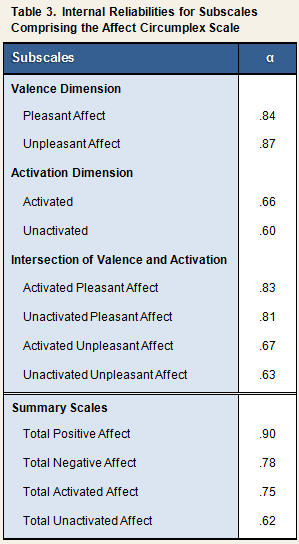State Affect (BCS, PCS1, PMBC)
TitleStudyBCS Copyright InformationNot a copyrighted scale Primary ReferencesZevon, M. A., & Tellegen, A. (1982). The structure of mood change: An idiographic/nomothetic analysis. Journal of Personality and Social Psychology, 43, 111-22. PurposeTo assess current (state) levels of positive and negative affect. Type of MeasureModified. The scale used in BCS included 30 items derived from the 60 mood adjectives identified by Zevon and Tellegen (1982) from their factor analyses of an initial pool of 117 affect-related words and phrases. DescriptionUsing a 5-point scale, respondents rated the extent to which each of 30 mood-related adjectives described how they had been feeling during the past week. The Mood States Scale was administered once during either of the 2 pre-challenge quarantine days, with 15 items each being included as a part of questionnaire sets 1 and 2, respectively (see Table 1). Scaling0 = Not at all, 1 = A little, 2 = Moderately, 3 = Quite a bit, 4 = Extremely Number of Items30 Scoring/VariablesState positive and negative mood subscales derived from the Zevon & Tellegen (1982) factor analysis are displayed in Table 1. The table also contains data on scale internal consistency (Cronbach’s α) as computed in the BCS sample of 399.
|
TitleState Adjective Questionnaire – State Affect Scale (22-item [PCS1]; 18-item [PMBC]) Studies
|
TitleState Adjective Questionnaire - Affect Circumplex Scale StudyPCS1 Copyright InformationNot a copyrighted scale Primary ReferenceLarsen, R. J., & Diener, E., 1992. Promises and problems with the circumplex model of emotions. In: Clark, M. S. (Ed.), Emotion. Newbury Park, CA: Sage Publications. PurposeTo evaluate two orthogonal dimensions of state affect: valence and activation. Type of MeasureCreated. The theoretical basis of the measure was derived from Larsen & Diener’s (1992) Circumplex Model of emotion. The 25 items that comprise the Affect Circumplex Scale were included as part of the larger State Adjective Questionnaire (StAQ) that was administered in PCS1, and several overlap with those comprising the 22-item State Affect Scale described above. The primary difference between the two scales is that the Affect Circumplex Scale is designed in such a way that the valence (positive vs. negative) and activation (active vs. passive) components of state mood can be examined independently. DescriptionUsing a 5-point response scale, respondents indicate how accurately each of several adjectives describes how they had been feeling during the past 24 hours. The StAQ Affect Circumplex Scale was administered once, on Quarantine Day 1. Scaling0 = Not at all accurate, 1 = A little accurate, 2 = Moderately accurate, 3 = Quite a bit accurate, 4 = Extremely accurate Number of Items25 Scoring/VariablesSubscale scores were computed by summing the response values of the component items (see Trait Adjective Questionnaire - Affect Circumplex Scale for details). Table 3 displays indicators of internal consistency (Cronbach’s α) for each of the subscales comprising the State Affect Circumplex Scale computed for the PCS1 sample (n=276).
|
TitleState Adjective Questionnaire – Stress-Arousal Circumplex Scale (Based on the Mackay Circumplex Model) StudyPCS1 Copyright InformationNot a copyrighted scale Primary ReferenceMackay, C., Cox, T., Burrows, G., & Lazzerini, T. (1978). An inventory for the measurement of self-reported stress and arousal. British Journal of Social and Clinical Psychology, 17, 283-284. PurposeTo evaluate two orthogonal dimensions of state affect: stress and arousal. Type of MeasureCreated. The theoretical basis of the measure was derived from Mackay et al.’s (1978) Stress Arousal Checklist (SACL; Mackay et al., 1978). DescriptionUsing a 5-point response scale, respondents indicate how accurately each of several adjectives describes how they had been feeling during the past 24 hours. AdministrationThe 20 items comprising the Stress-Arousal Circumplex Scale were included as a part of the larger State Adjective Questionnaire (StAQ), which was administered on Quarantine Day 1 (see PCS1 Trial Outline). Scaling0 = Not at all accurate, 1 = A little accurate, 2 = Moderately accurate, 3 = Quite a bit accurate, 4 = Extremely accurate Number of Items20 Scoring/VariablesFour subscales can be derived from the StAQ Stress-Arousal Circumplex Scale which each represent either the positive or negative pole of stress or arousal, respectively. Subscale scores are computed by summing the response values of the component items (see Trait Adjective Questionnaire – Stress-Arousal Circumplex Scale for additional details about scoring). |


